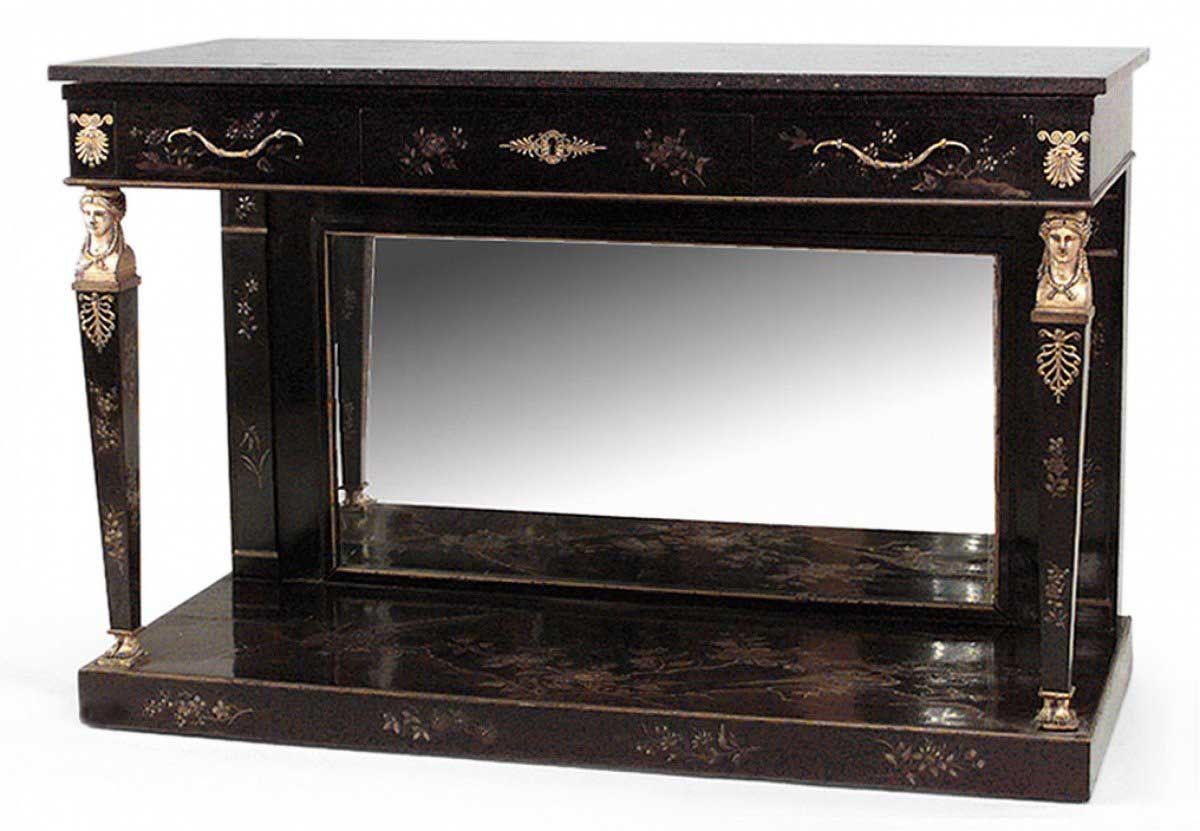X
{{ modalTitle }}
PLEASE FILL IN THE REQUIRED FIELDS.X
X
{{ modalTitle }}
Choose one of the options below.X
ITEM SUCCESSFULLY
ADDED TO PROJECT
Continental Empire Black Lacquer Chinoiserie Console Table
 Continental
Continental Dutch
Dutch Tables, Dining Room
Tables, Dining Room Console/Wall Tables, Sideboards and Buffets
Console/Wall Tables, Sideboards and Buffets
Newel Warehouse
32-00 Skillman Ave
Long Island City NY - 11101
 (212) 758-1970
(212) 758-1970
Continental Empire Black Lacquer Chinoiserie Console Table

Newel Warehouse
32-00 Skillman Ave
Long Island City NY - 11101
 (212) 758-1970
(212) 758-1970
 Tables, Dining Room
Tables, Dining Room Console/Wall Tables, Sideboards and Buffets
Console/Wall Tables, Sideboards and BuffetsConsole table
Starting in the 17th Century, console tables were side table usually fixed to a wall with front legs for support. Frequently the backside of consoles are left undecorated as they are viewed only from the front or sides and were created with the intent of display, often serving as pier table underneath a large mirror. Contemporary references to console tables can also indicate a freestanding relatively tall, rectangular table that is placed against a entrance wall or sofa.
Chinoiserie
Chinoiserie is the European adaptation of Oriental designs. Chinoiserie can be dated back to the beginning of the 17th Century French, Rococo and Regency periods. The term chinoiserie comes from the word “chinois” which is French for “Chinese”. Common chinoiserie prints and motifs include foo dogs, pagodas, nature scenes, and dragons.
Empire
A period of design during the reign of Napoleon I. It was most prevalent between 1800 and the late 1820s. It was considered the second wave of neoclassicism and marked a return to ostentatious design, a departure from the more conservative Directoire period that directly preceded it. It was intended to idealize the majesty of the French state and Napoleonic rule. Mahogany was the most popular wood during the period, and brass ornamentation and dark marbles were in vogue. Greek, Roman, and Egyptian motifs were also widely used. The style spread throughout Europe and appeared in America in some of Duncan Phyfe's work.
Lacquer
A resin-based varnish sometimes with pigments added that is applied to metal or wood to give a high-gloss finish. Mother-of-pearl, coral, and metals are often inlaid in the lacquer to create a decorative effect.
Console table
Starting in the 17th Century, console tables were side table usually fixed to a wall with front legs for support. Frequently the backside of consoles are left undecorated as they are viewed only from the front or sides and were created with the intent of display, often serving as pier table underneath a large mirror. Contemporary references to console tables can also indicate a freestanding relatively tall, rectangular table that is placed against a entrance wall or sofa.
Chinoiserie
Chinoiserie is the European adaptation of Oriental designs. Chinoiserie can be dated back to the beginning of the 17th Century French, Rococo and Regency periods. The term chinoiserie comes from the word “chinois” which is French for “Chinese”. Common chinoiserie prints and motifs include foo dogs, pagodas, nature scenes, and dragons.
Empire
A period of design during the reign of Napoleon I. It was most prevalent between 1800 and the late 1820s. It was considered the second wave of neoclassicism and marked a return to ostentatious design, a departure from the more conservative Directoire period that directly preceded it. It was intended to idealize the majesty of the French state and Napoleonic rule. Mahogany was the most popular wood during the period, and brass ornamentation and dark marbles were in vogue. Greek, Roman, and Egyptian motifs were also widely used. The style spread throughout Europe and appeared in America in some of Duncan Phyfe's work.
Lacquer
A resin-based varnish sometimes with pigments added that is applied to metal or wood to give a high-gloss finish. Mother-of-pearl, coral, and metals are often inlaid in the lacquer to create a decorative effect.
Console table
Starting in the 17th Century, console tables were side table usually fixed to a wall with front legs for support. Frequently the backside of consoles are left undecorated as they are viewed only from the front or sides and were created with the intent of display, often serving as pier table underneath a large mirror. Contemporary references to console tables can also indicate a freestanding relatively tall, rectangular table that is placed against a entrance wall or sofa.
Chinoiserie
Chinoiserie is the European adaptation of Oriental designs. Chinoiserie can be dated back to the beginning of the 17th Century French, Rococo and Regency periods. The term chinoiserie comes from the word “chinois” which is French for “Chinese”. Common chinoiserie prints and motifs include foo dogs, pagodas, nature scenes, and dragons.
Empire
A period of design during the reign of Napoleon I. It was most prevalent between 1800 and the late 1820s. It was considered the second wave of neoclassicism and marked a return to ostentatious design, a departure from the more conservative Directoire period that directly preceded it. It was intended to idealize the majesty of the French state and Napoleonic rule. Mahogany was the most popular wood during the period, and brass ornamentation and dark marbles were in vogue. Greek, Roman, and Egyptian motifs were also widely used. The style spread throughout Europe and appeared in America in some of Duncan Phyfe's work.
Lacquer
A resin-based varnish sometimes with pigments added that is applied to metal or wood to give a high-gloss finish. Mother-of-pearl, coral, and metals are often inlaid in the lacquer to create a decorative effect.


















